I do not recall which grade level I was but I knew of our Banaue rice terraces through one of our Social Studies text books in elementary. Back then, the rice terraces were sometimes referred to as the "eight wonder of the world." The rice terraces are popular because as history has it, those were carved in the mountains by the ancestors of indigenous people in the area from hundreds of years ago. Given the age of the terraces, it is assumed that the terraces were all hand-made, no heavy machinery used. I think this is what makes the terraces very popular given the thought of diligence and industriousness of those who made them.
For someone who was born in the middle of the mountains, I thought everything I see in books stop there. In high school, I got the chance to visit Banaue when I joined the regional Math Olympiad competition which was held in Lamut, Ifugao. Since that trip was hosted by the school then we did not have the opportunity to go looking farther around. We just followed the teachers' itinerary. We went visiting a rice terraces site but I no longer remember which it was among the five rice terraces sites in Banaue.
The rice terraces are very popular as I see photos of our rice terraces on social media, both from locals and foreigners alike. I have to admit, I envy them. It is funny that foreigners are able to see our wonders while I have challenge seeing them. After decades, I finally had the opportunity to again visit Banaue and this time with a greater purpose through fund-raising travel for a cause and outreach at the same time.
Banaue rice terraces have two of the five rice terraces in our Cordillera region that were inscribed on the UNESCO World Heritage List. One of those two rice terraces in Banaue is in a barangay (village) called Batad. This is where we had the outreach and the chance to witness one of our very own world-class heritage.
Geographical location
The province of Ifugao is in the Cordillera region (officially called Cordillera Autonomous Region or CAR) which is in turn in the northern part of the country. It is around 390 kilometers from Metro Manila and has highest elevation of 2,926 meters above sea level.

The terraces in Batad village that are covered on this post is 1,100 meter elevation as noted on this UNESCO marker going to the site.
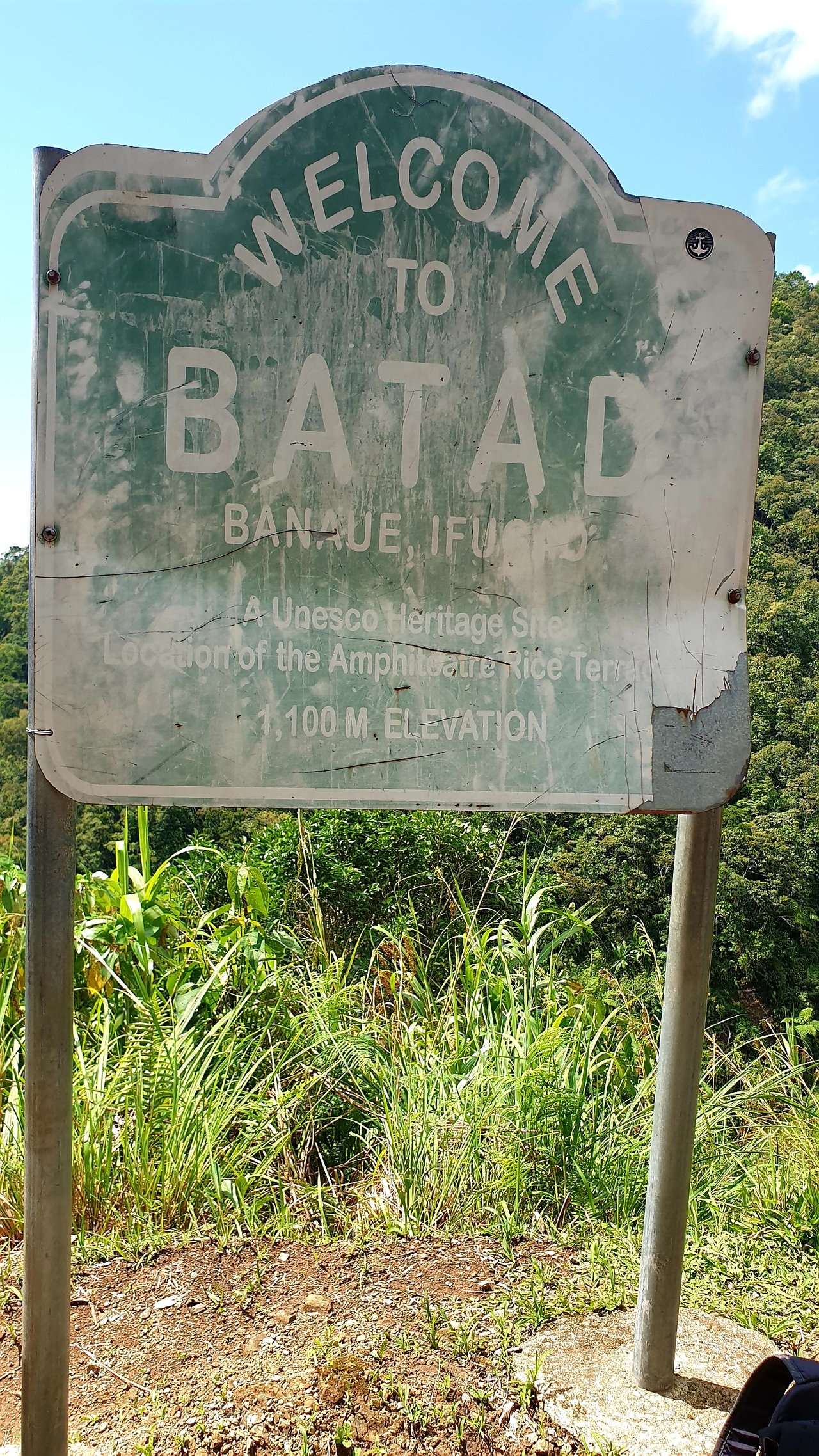
When to go there
It is best to go to Banaue during dry season from December to June. It is still possible to go there by July or August but keep in mind that rainy season starts on these early months. Unpredictable as it is, weather may not be favorable during these months. More so, avoid going there in September and October because these months are often the typhoon season in the Philippines.
How to get there
If you have your own means of transportation then it will be pretty easy. Just load Google Maps or Waze and off you go. If you are taking public transportation from Metro Manila then you can book for bus trip through Coda Lines or Ohayami Trans through the https://12go.asia website. The buses travel up to Banaue main town only. From the town, you need to take another ride of either jeepney or tricycle to go to the Saddle which is the closest point to Batad where a vehicle can go. Fare for the jeepney ride is about P150.00 (US $2.91).
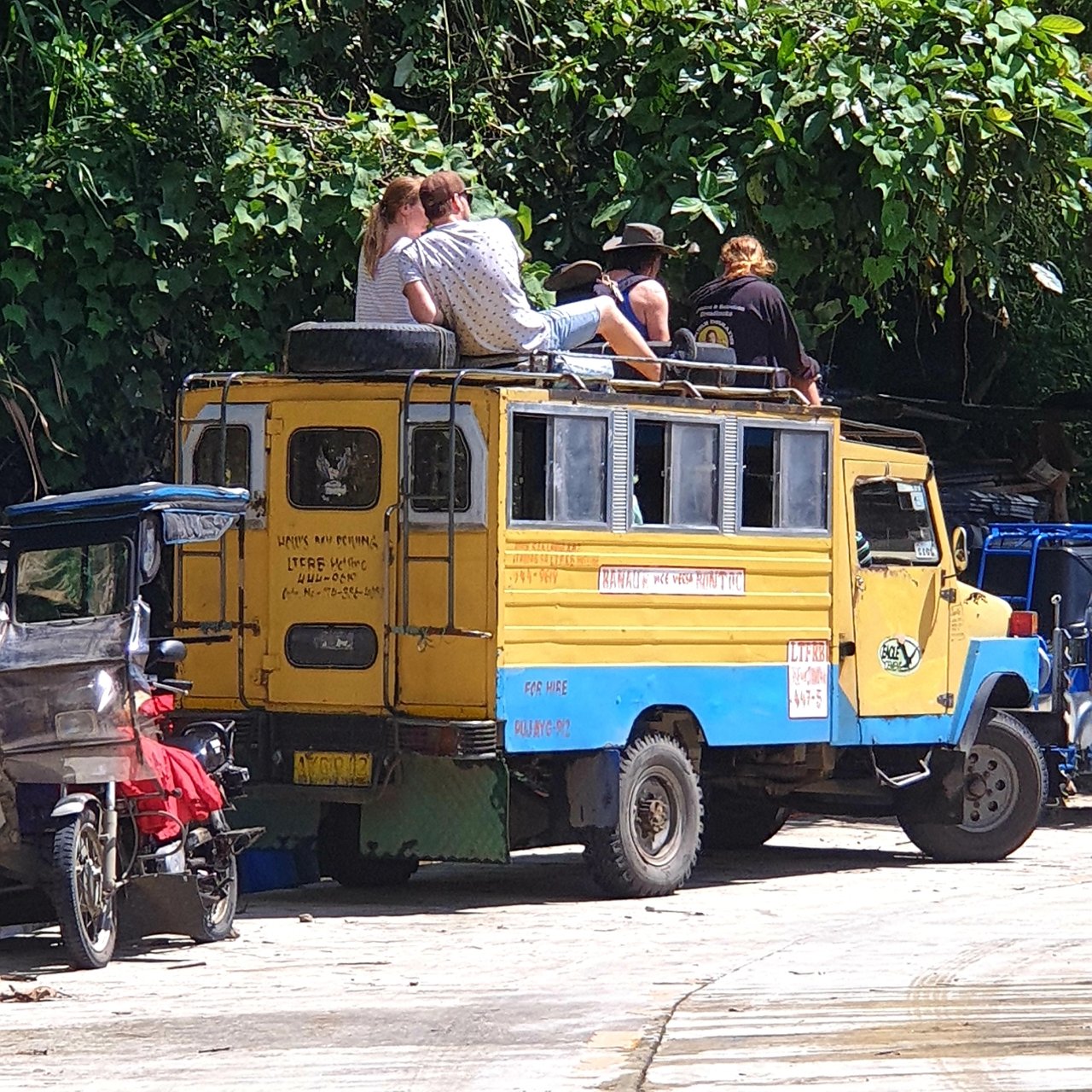
The jeepney goes to Batad twice a day but the challenge with this is that the place to find these vehicles and the time when these leaves for Batad are not certain. If you are not able to catch the jeepney trip, you can rent one for special trip. It is obviously more expensive though since you will be renting a whole vehicle for your own transport. If you are traveling as a big group of more than ten persons, it will be more economical though since rent for the whole vehicle is ten times the fare per person.
The tricycle ride can accommodate up to three persons and costs P150.00 for the whole trip.
You can arrange for either the jeepney or tricycle to pick you up from the Saddle during your return trip.
Where to Stay
We stayed at Foreigner's Inn but there are many other inns in the village. You can go to either https://www.agoda.com or https://www.booking.com and search for Batad. You may be surprised to see that there are fairly many options to stay in the middle of the mountains.
Our Descend
Now that you have an idea of how to get there, let me share the rest of our day after our outreach finished by mid-afternoon last 06 July 2019.
At the end of the road in the Saddle, I spotted this old way of drying rice grains. This used to be very common along the Pan-Philippine highway when I travel to and from Baguio City-Metro Manila. I hated it because grains of sand were swiped along with the grains and it is very hard to pick and separate them. That is not safe and threat to health when the grains of sand get mixed up with cooked rice. I am not sure which year it was when a law was passed to prohibit doing this as I haven't seen it done for a long time already. I was surprised to see it now. Maybe they need to be reminded that this is prohibited.
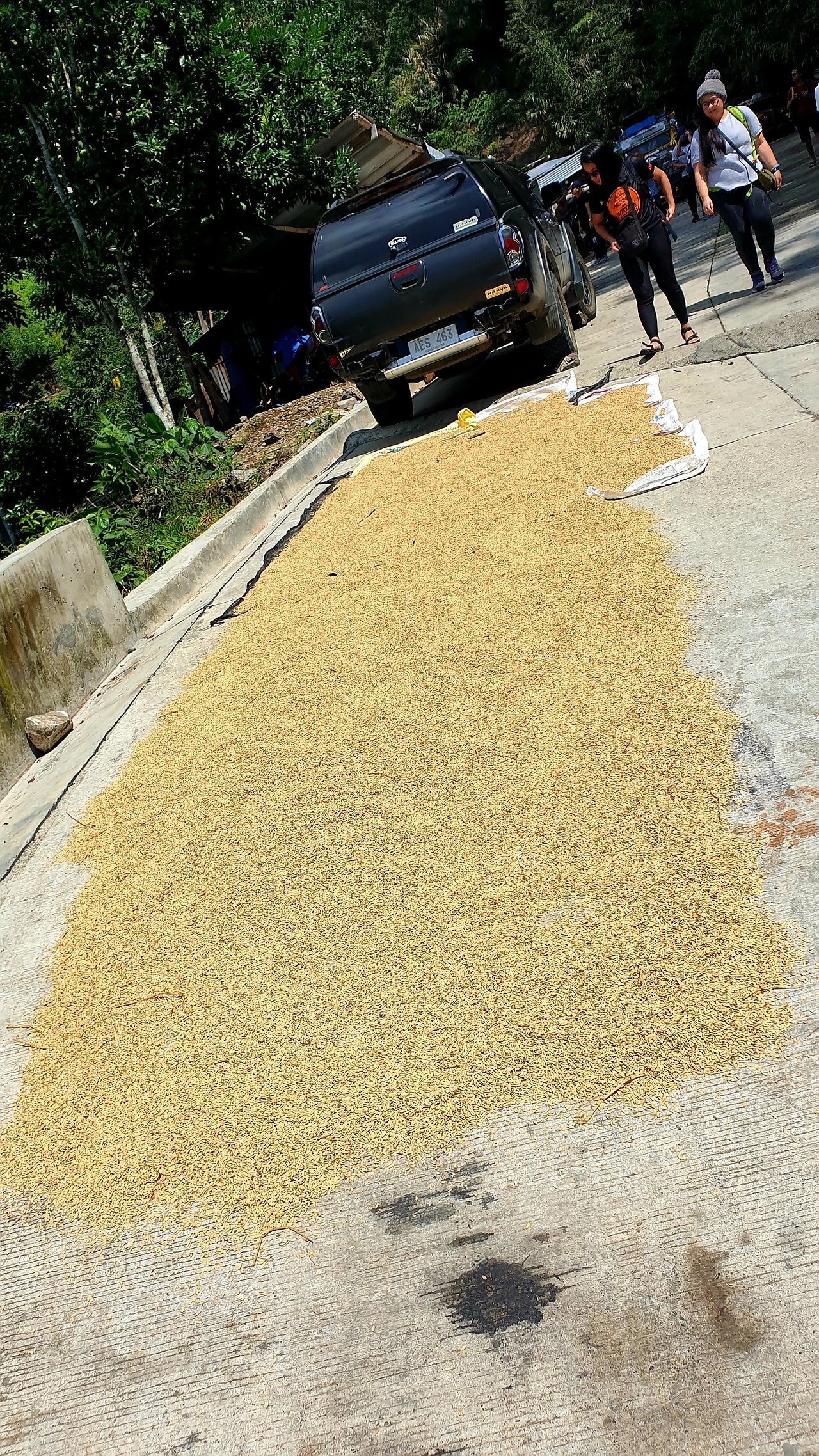
While we were cleaning up and ready to leave the school where we held the outreach, one of the locals beside me said, "I think you will be staying down in the main village."
"Foreigner's Inn. Is that down somewhere?" I asked.
"I am not sure of the name of the inn but you will be in the main village, near the church."
"What's that again? The main village is down there? We are in the school area so I thought we were already in the main village. Could that mean that the main village is in a farther remote area?" I thought but instead said "How long will the descend to the main village be?"
"About ten to fifteen minutes."
"E-Z," I thought.
Two of my fellow volunteers, Justine and Anne, have become my sparring partners and we went in tandem. We started the descend at the back of the school while others were following. That was when I realized how steep the pathway was. To give you and idea, you can estimate the slope from this photo where the children were standing almost parallel to the slope. I thought it was 80°. I was not afraid of the descend but I had to be more careful this time. I can not skip like when we came down to the school because there are areas where we have to descend facing the slope. It is like crawling down because the steps on a riprap are very narrow stones that is not enough to hold a full foot.
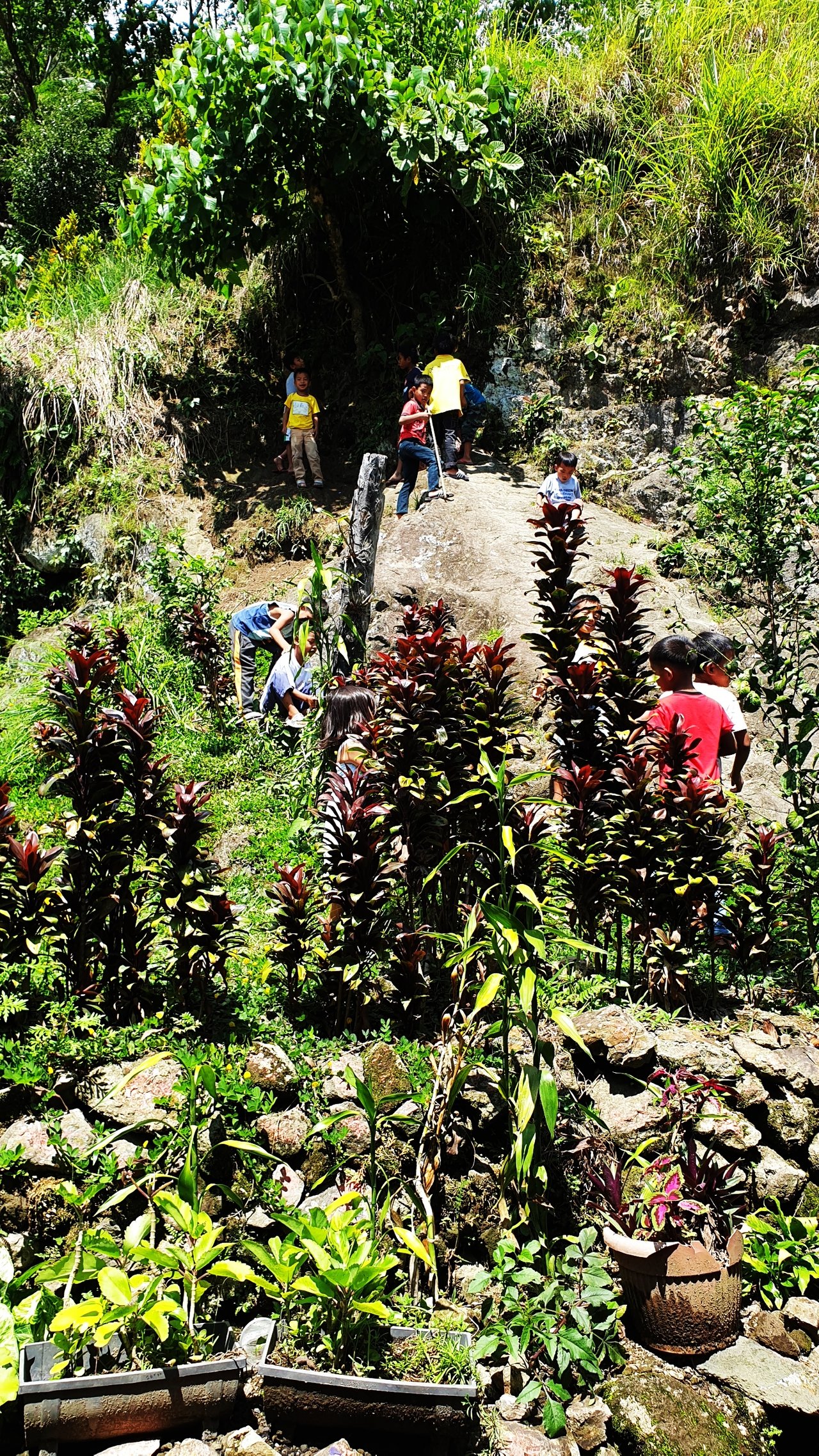
Along the pathway down are few sign boards of inns in the area. These leads to the other inns while I can not find a direction to ours. They said it is down there below anyway so we jut kept going down.
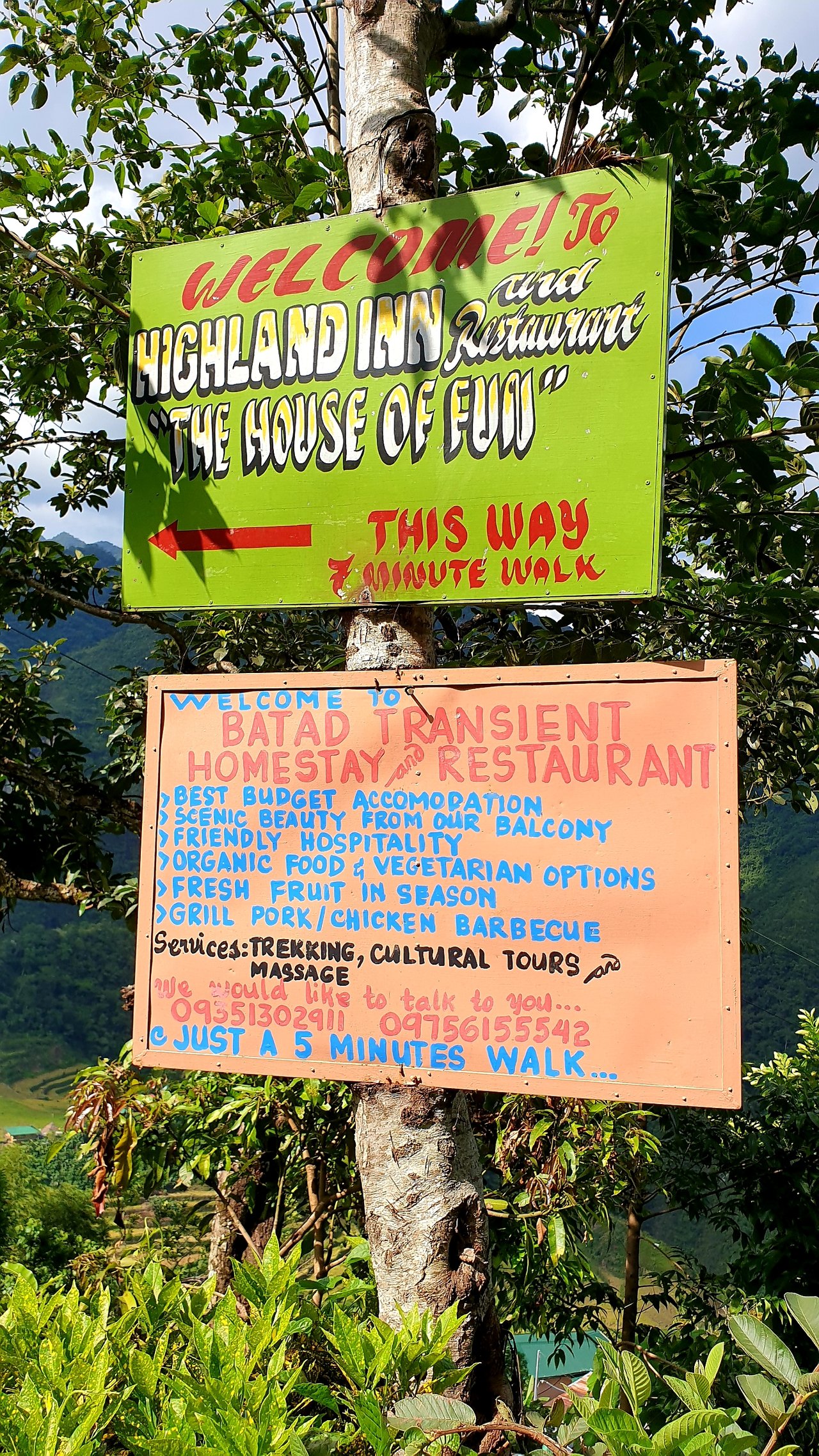
When we reached a somehow unobstructed area, this view of the rice terraces came in to sight to our left. We all stopped and gasped. What sight to behold!
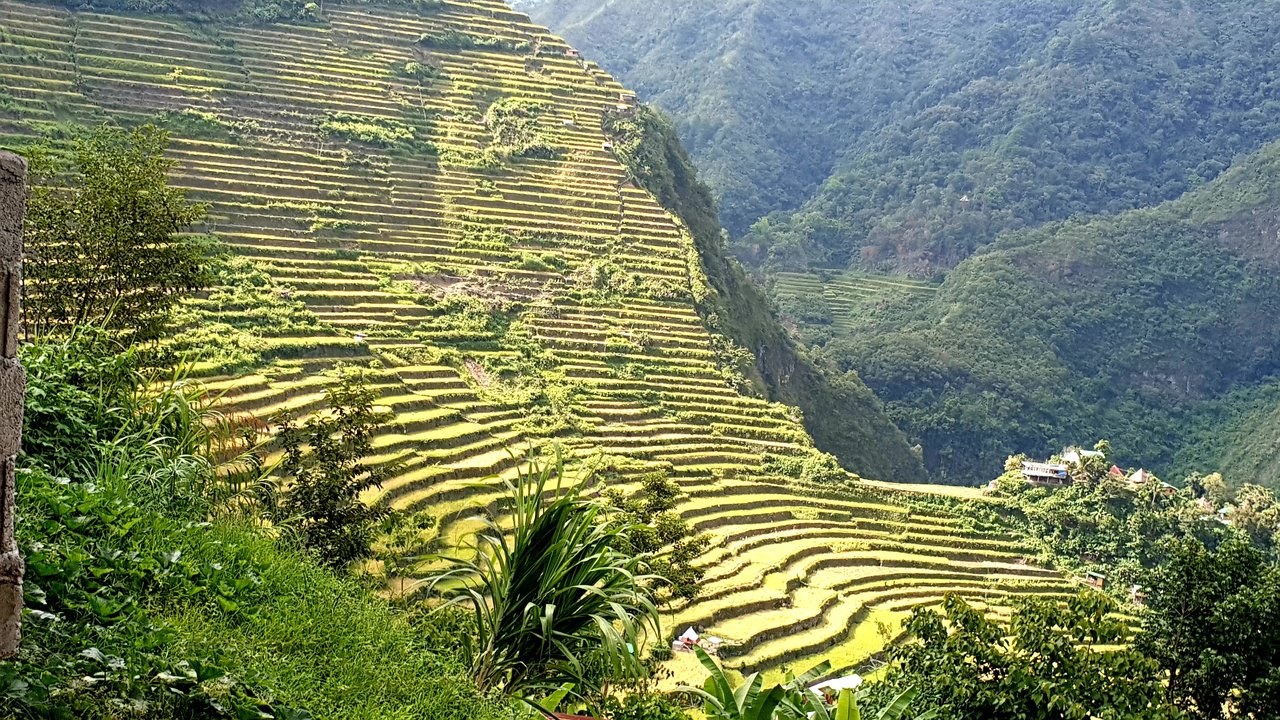
After we recovered from our awe, Justine was so ecstatic. She was like a child who saw her favorite toy and jumping with glee.
"Ay, ang ganda-ganda dito! Gusto kong tumira dito!"
"It is so beautiful here! I want to live here!"
I was still speechless. Finally, the ones I see in books and on social media which seemed so unreachable are now right in front of me.
We stopped for few minutes for photo shoots. That was when I noticed the houses on the mountain slopes to the right. They are no longer the native houses that were in the books. They are modern style now.
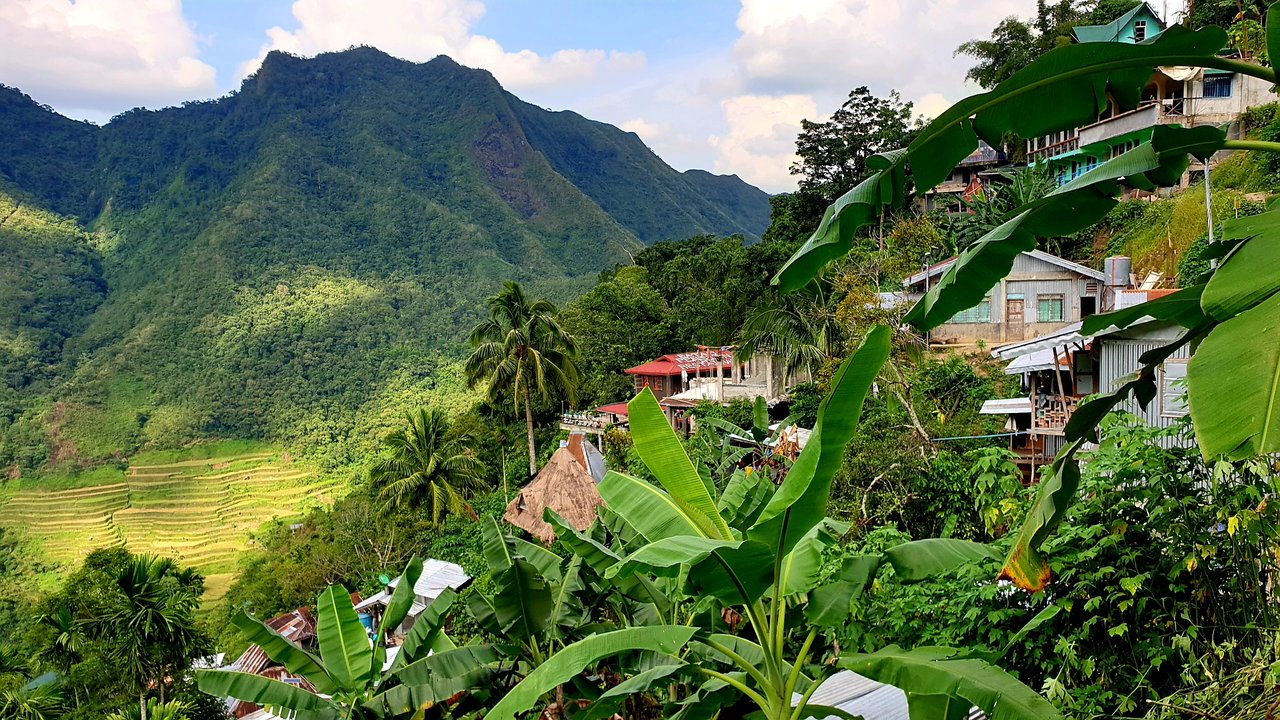
I wondered if there are any native houses left in the area and to my amusement, we saw a few of them as we continued our descend.
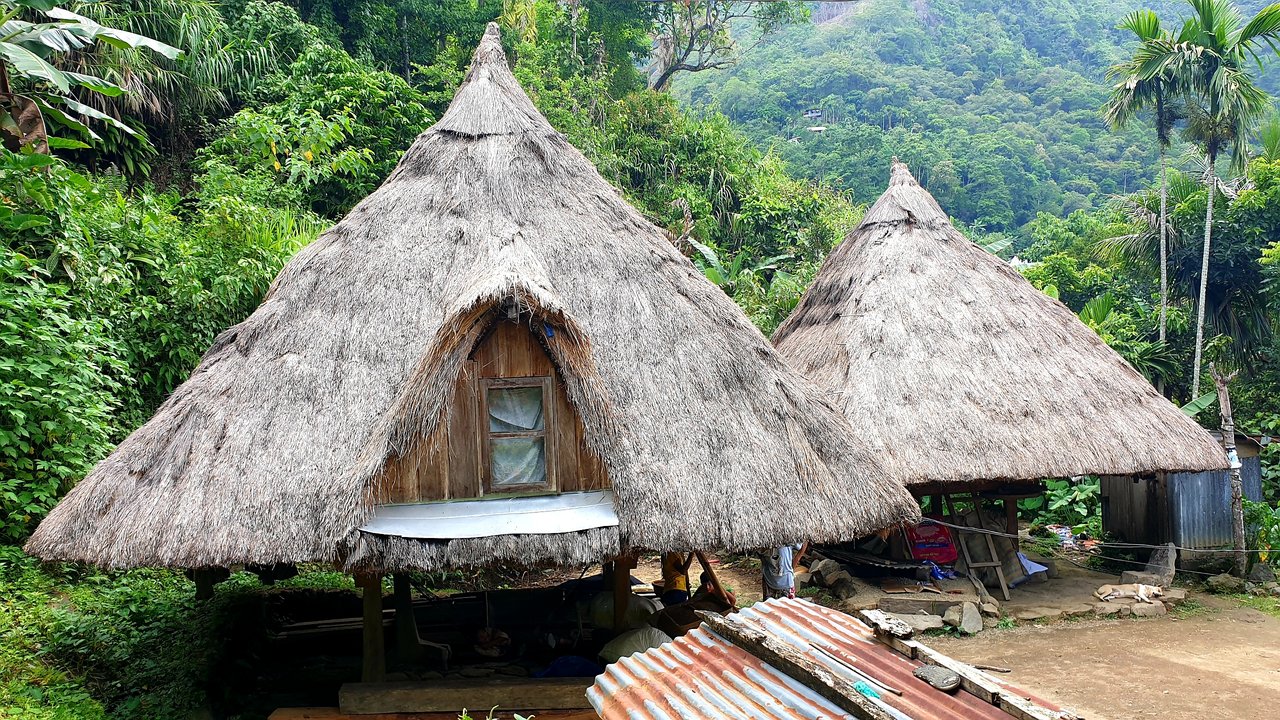
But where is the main village? We do not know where our inn is. We just kept on descending as we know we will find it out somehow.
Going little left from the modern houses are these mountains with that little terraces in the middle. We have mini-terraces, yeah? I wonder if anyone of the villagers plan to develop those untouched mountains and make them terraces too.
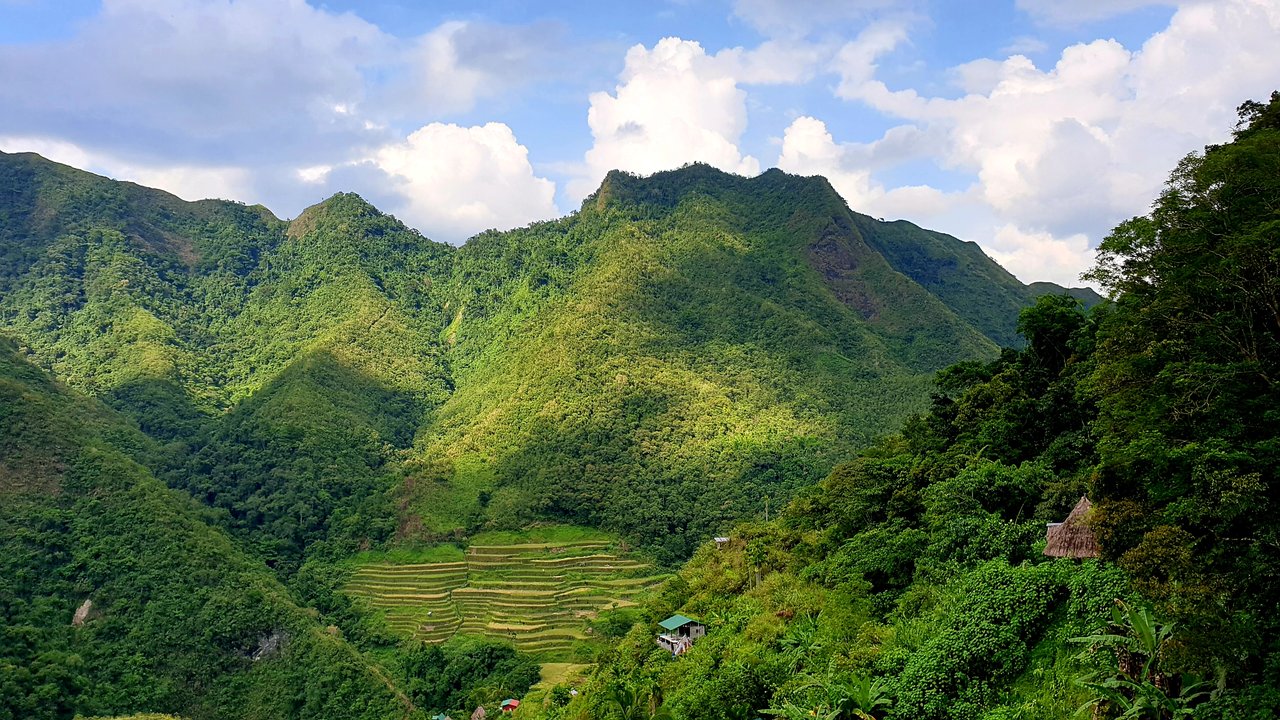
A little farther down and we came to another breath-taking view. This time, we see houses in the middle of the rice terraces. We again stopped to feel and appreciate the beauty in front of us.
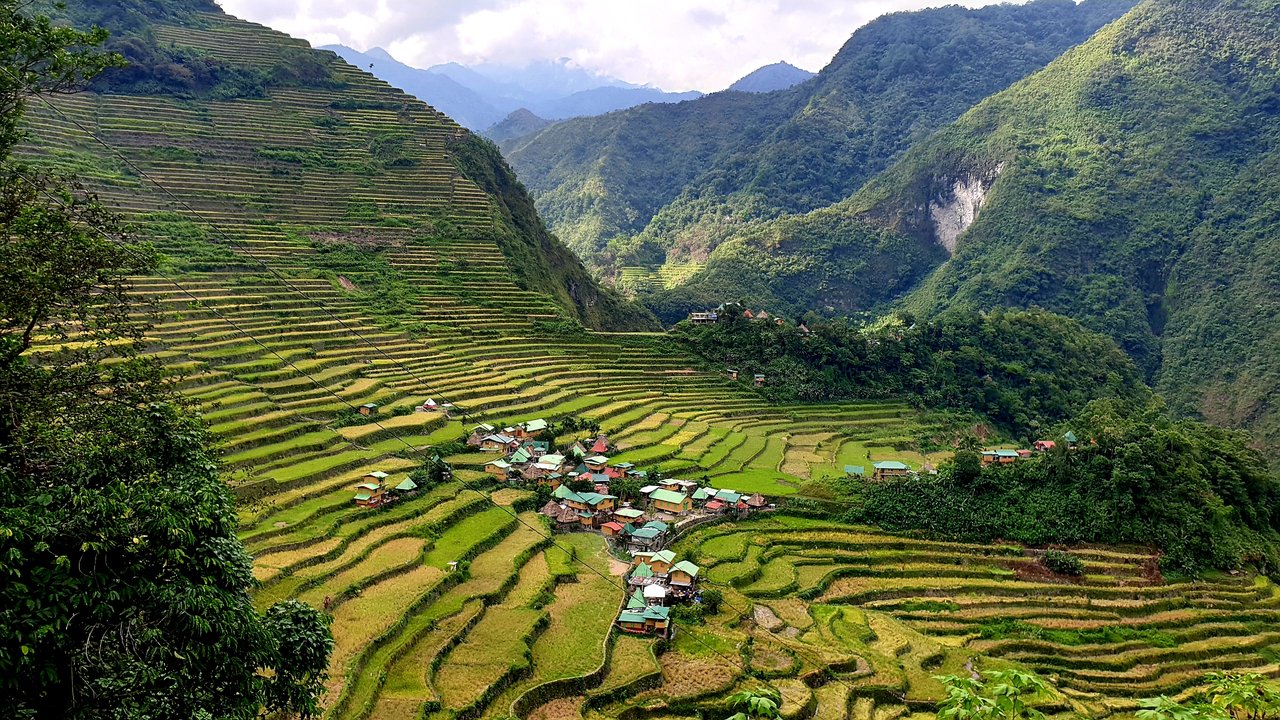
Few of the children who recognized us from the outreach up in the school were mingling around. One of them mentioned that that area where the houses are is the main village.
"That is already the main village?" I thought. I wonder if there are even thirty households in there. If this is already the main village with very few households then I wonder how much more for those in farther and more remote areas. No wonder there are areas with no supply of electricity.
We again stopped to take more photos.
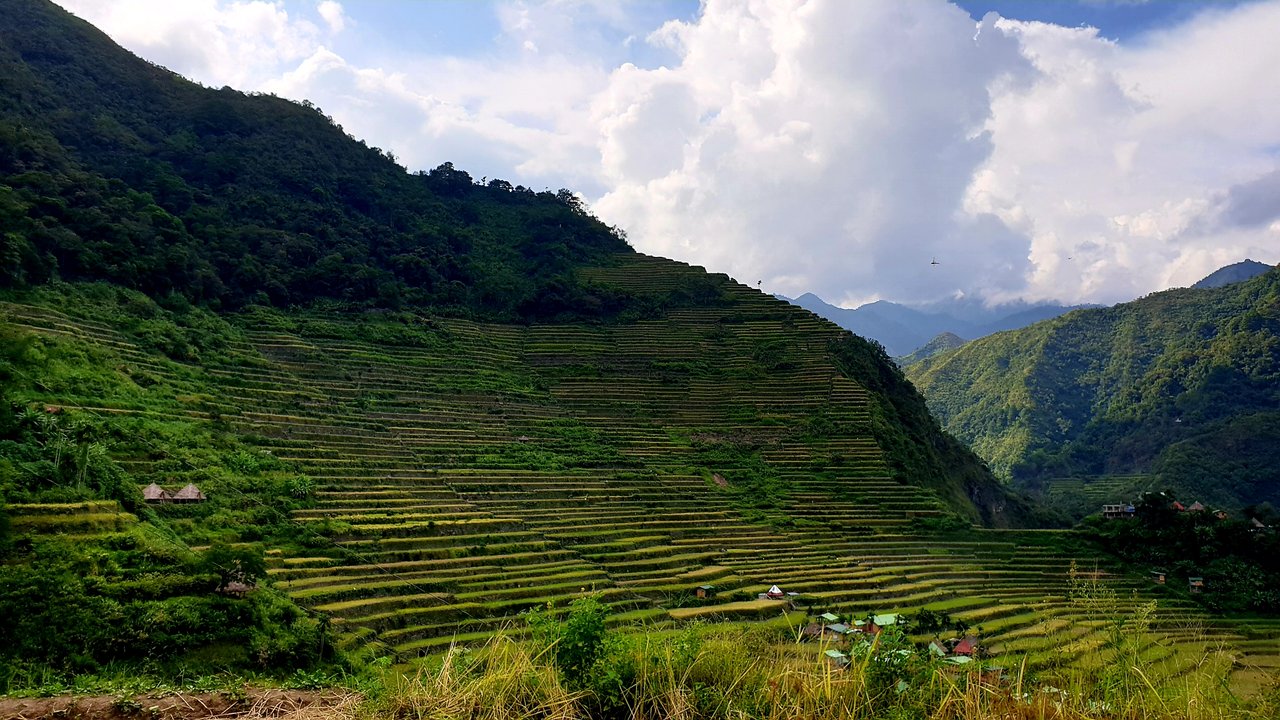
I can't remember how many shots I had on this spot.
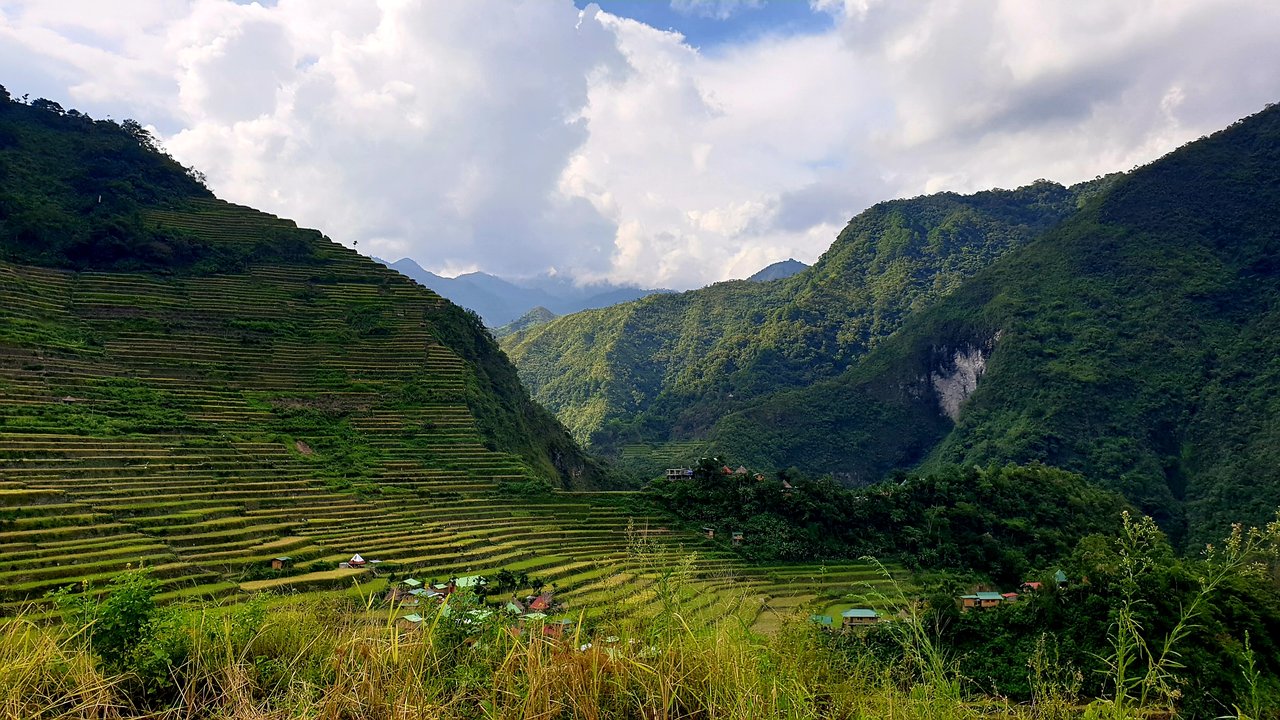
That was when some of our fellow volunteers where able to catch us up. Now it is time for groupie. Justine is the one with shawl to my right, Anne is the one raising her hand behind Justine.
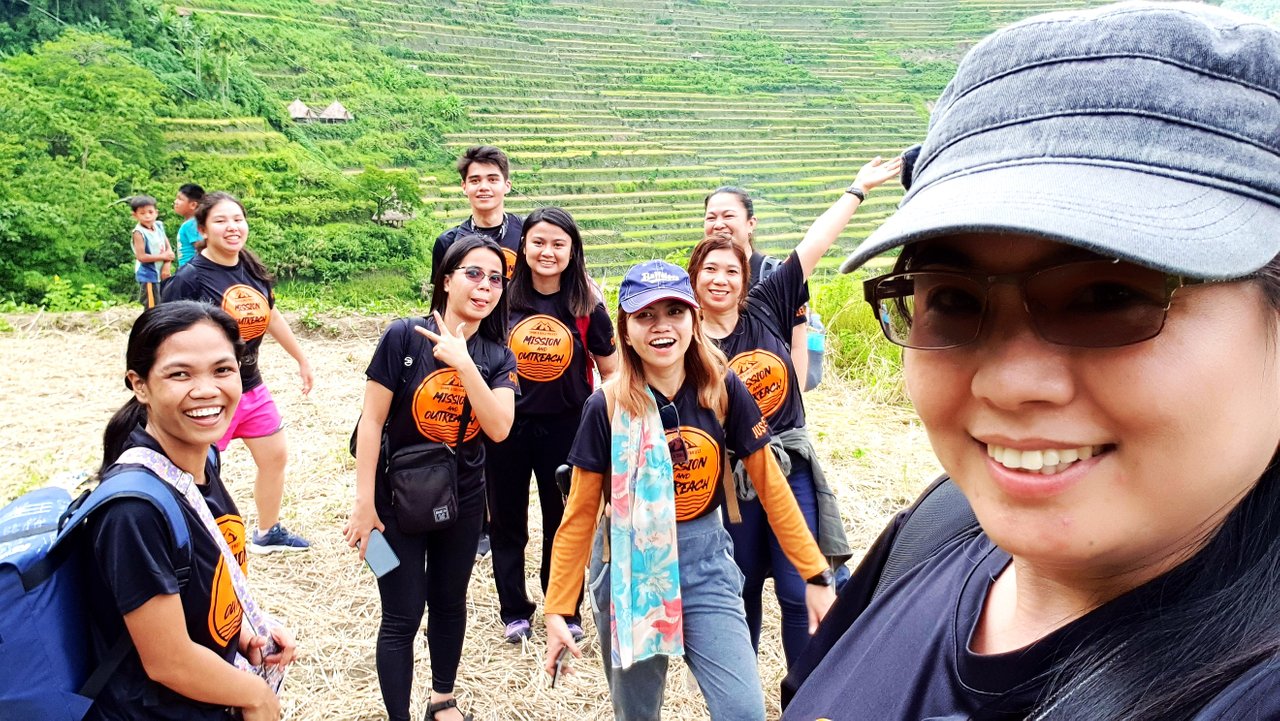
Then we three again went on our way. The others were left a little behind. Somewhere along the way, we met three Caucasian foreigners going up. The guy was leading few steps away from the two women following through. I guessed that the guy and the second (and younger woman) are siblings, the third woman is their mother. I got passed by the guy and when I got closer to the younger woman, she stopped and bent, holding on to her knees.
I greeted her. "How was it?"
She was obviously struggling but I just wanted to start a conversation because she's just in front of me and she's panting.
"I will never ever do it again," she answered in between her breath.
"Oh, no. When you do something new and it hurts, they say that you actually have to do it again for your body to get used to it," I said.
"No! If you do something and there is pain, that means something is wrong so you don't do it again." Those were said in a firm tone so I kept quiet.
Anne took over and asked if she can take photos with them. They did. That saved the conversation!
Farther down we went. We are now getting closer to the level of the village. And I feel the nature even more closer. Getting this close to the rice terraces made me miss my childhood. My father had small terraces in Zambales where I was born. There were three to five layers which I used to run along the dikes and my mother would try to stop me by scaring me that I may fall down the lower level. She was not able to stop me and I never fell somehow.
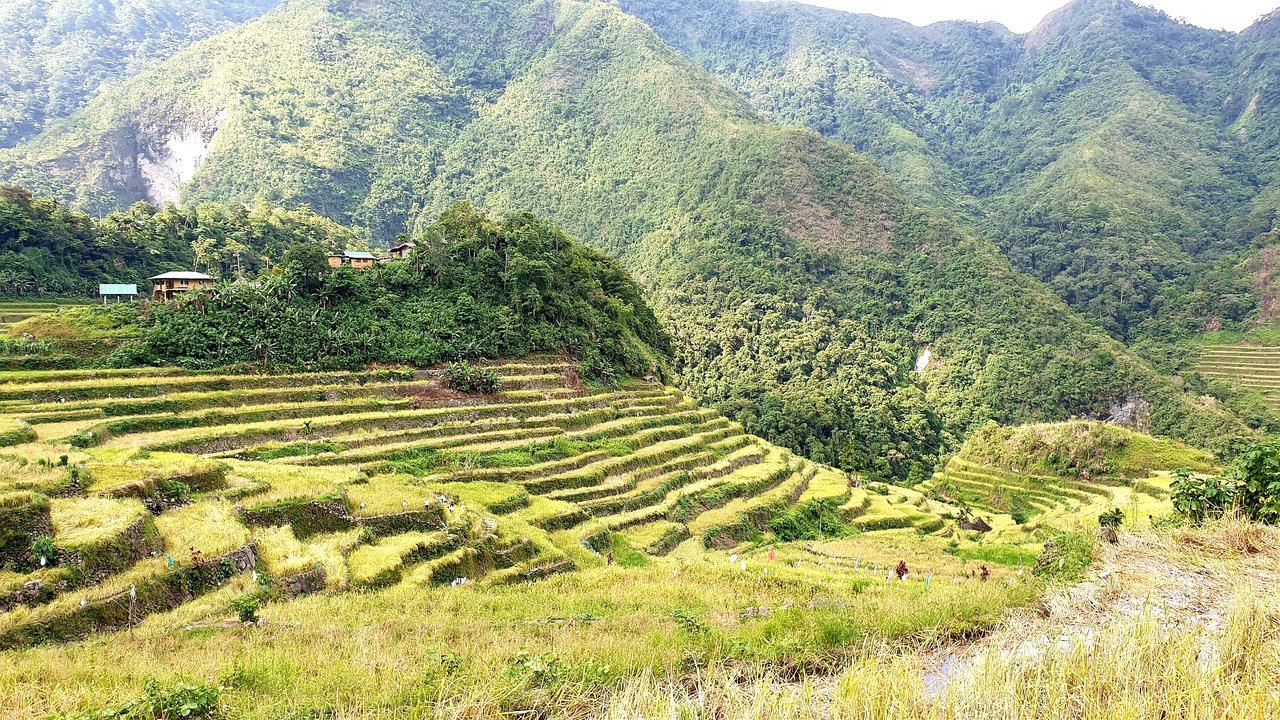
Okay, here we go now at the level of the main village. Why, it feels like getting closer and closer to home.
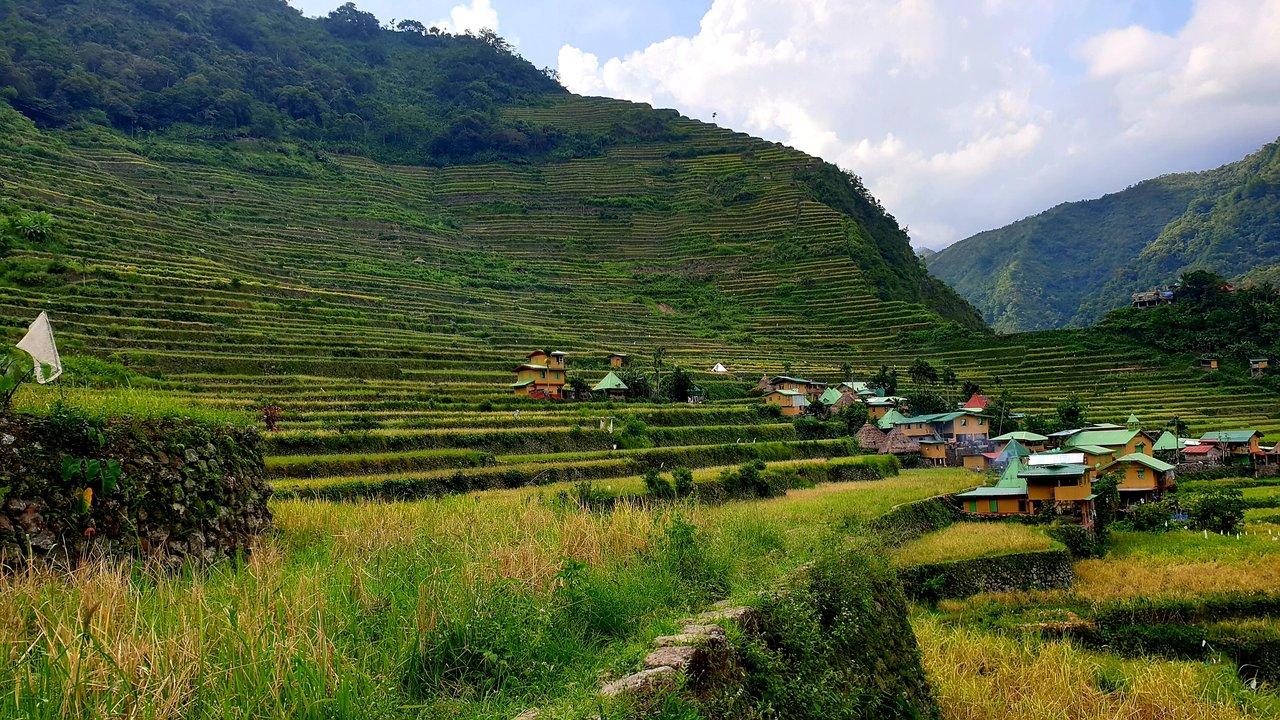
There were just the three of us on that level. The others were still up there so we enjoyed the view to ourselves. Here is to Justine and Anne enjoying their poses.
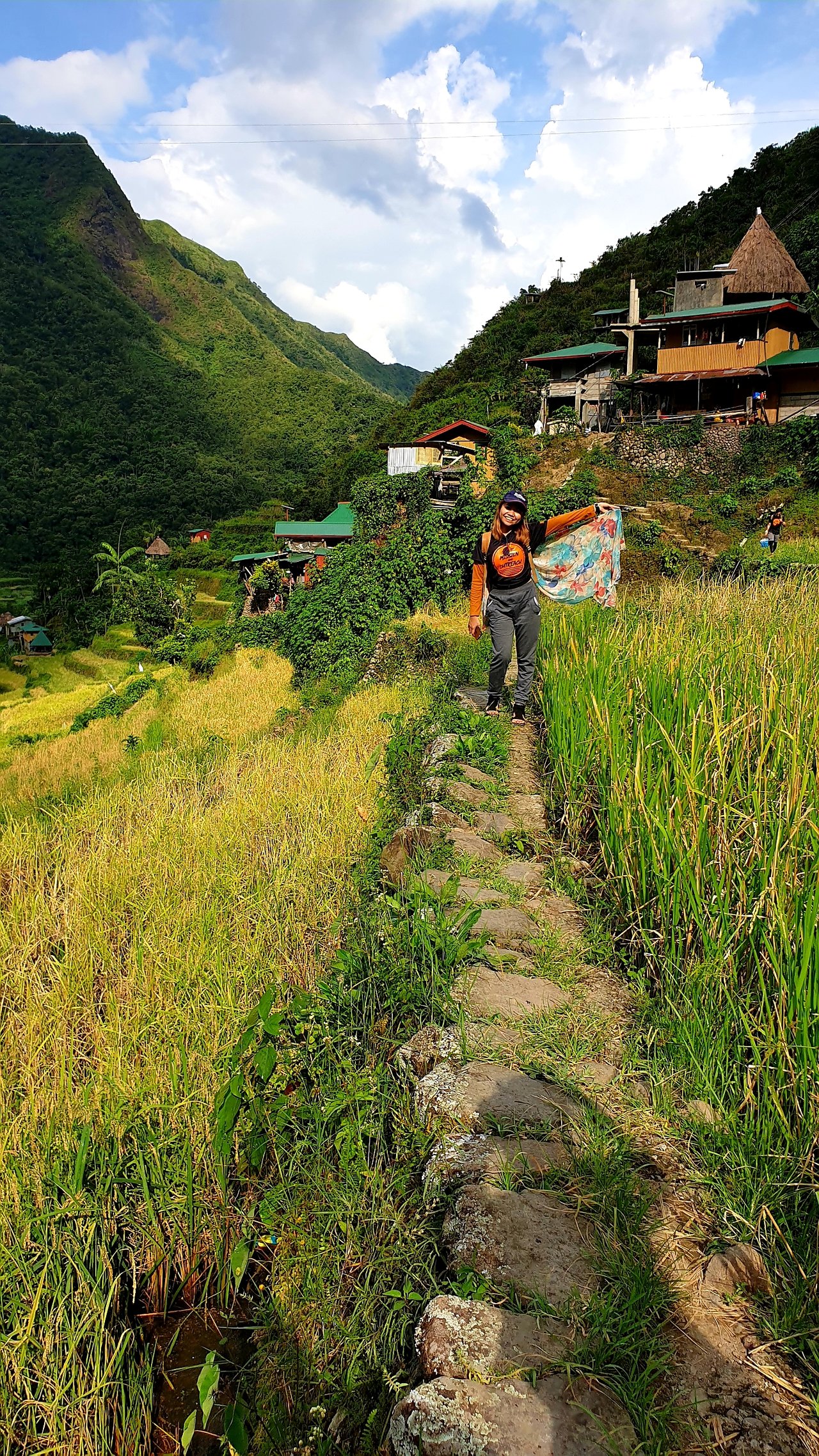
There goes Anne trying to keep her balance.
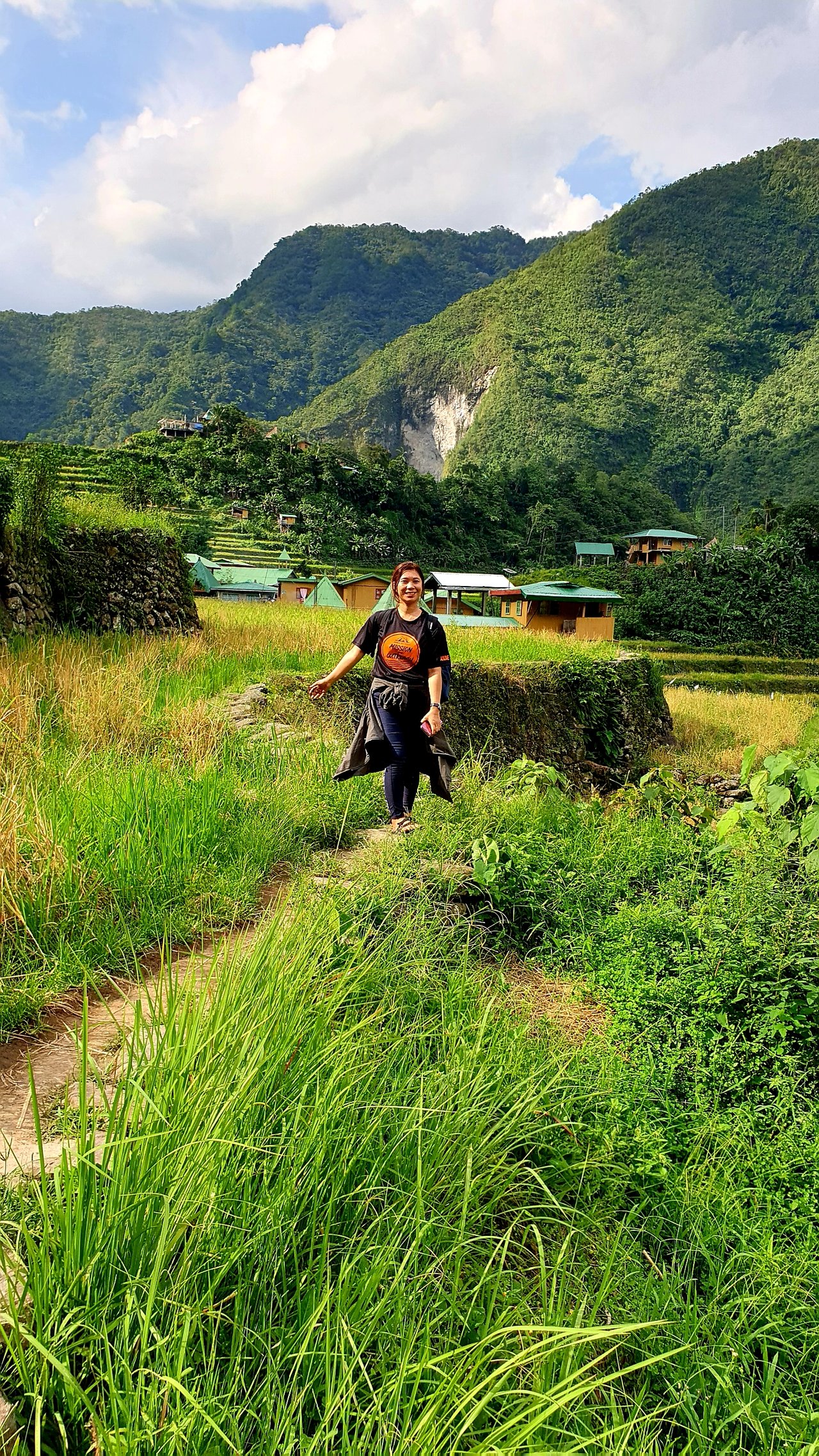
As I go long the dikes, I noticed their irrigation system. It looks like the water supply is fully natural coming from the mountains. The current is fairly strong and free-flowing. This is one great advantage that sustains the rice fields. It is July and the rainy season has started. I just hoped the water supply does not totally dry up during summer.
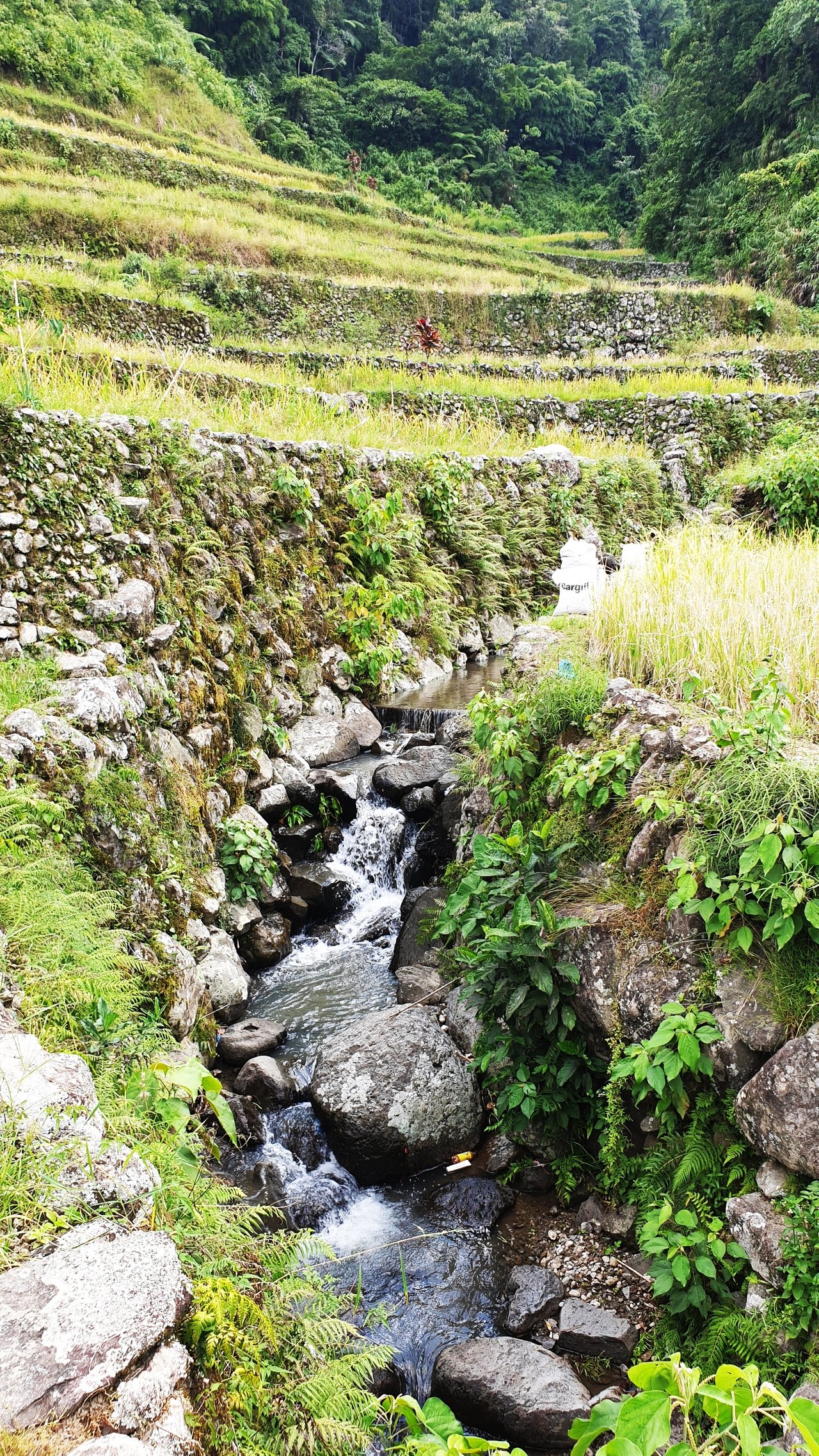
Now that we got closer that I noticed the plastic sheets hung across the fields. Those are being used as scarecrows. I smiled at the thought of it because my parents never tried this technique. I wonder how effective they are.
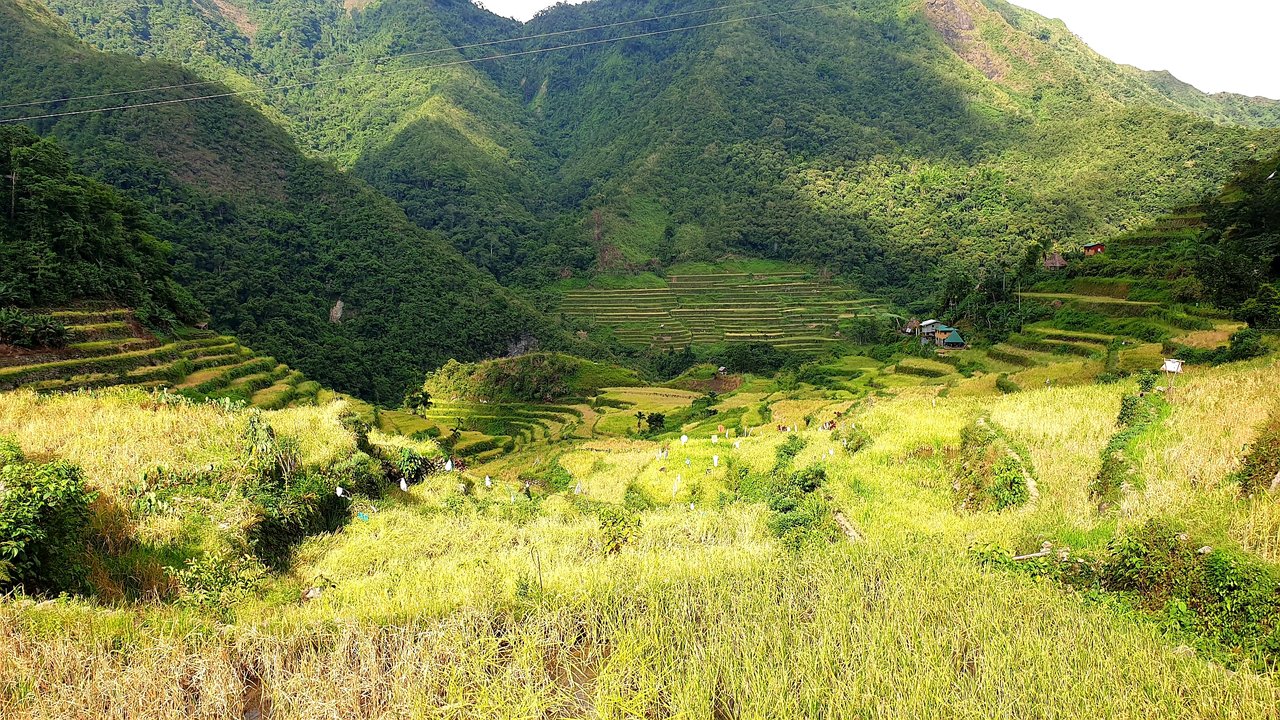
By the looks of the cut stalks, the crops have already been harvested from some of the fields for a fairly long time. I wonder when they plan to till the fields and plant again. I do not remember the cropping cycle that my parents used to follow.
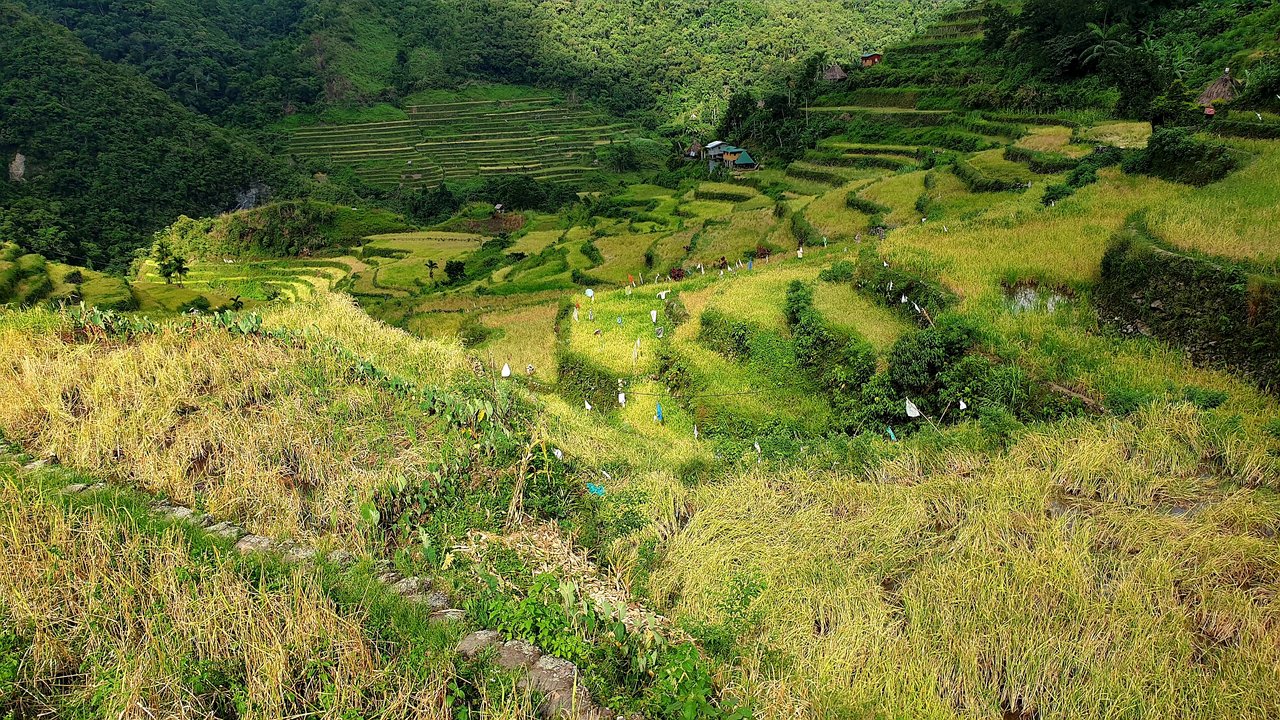
Along my path, I spotted a dragonfly. Yeah, these little creatures do not usually pass my attention so I caught this one. Can you see what I see?
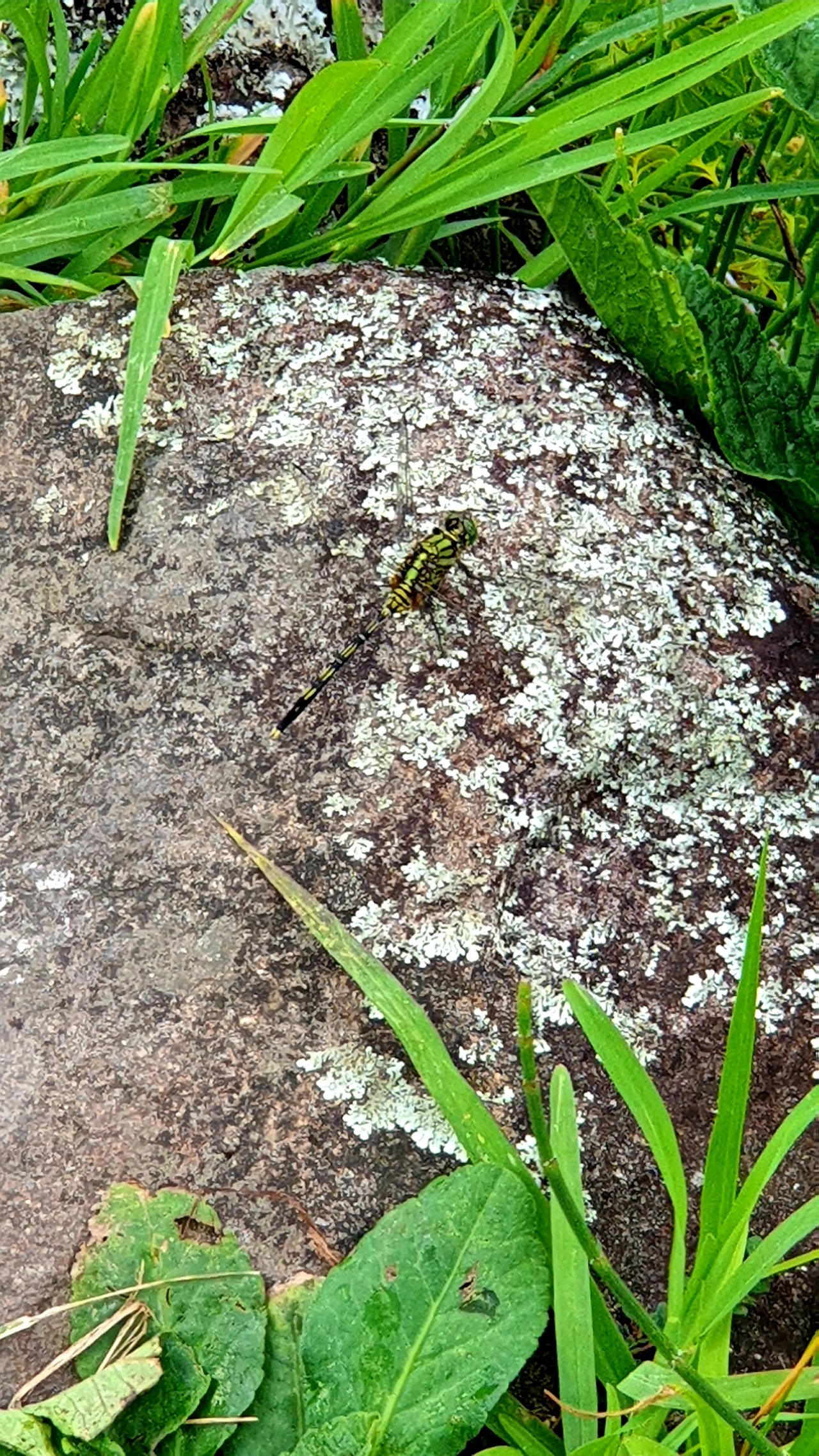
Justine and Anne are now closing in so off to the inn, we continue. Somewhere up back there, people were saying that our inn is the one with green roof. I kind of laugh at the description because many of the houses in the main village has green roof. Anyway, we will find ours regardless of that. As we drew near, people were pointing to the one beside the native houses. Now, that is more appropriate to spot. Can you read the banner hung beside the left post? I can not but it says "Foreigner's Inn and Restaurant."
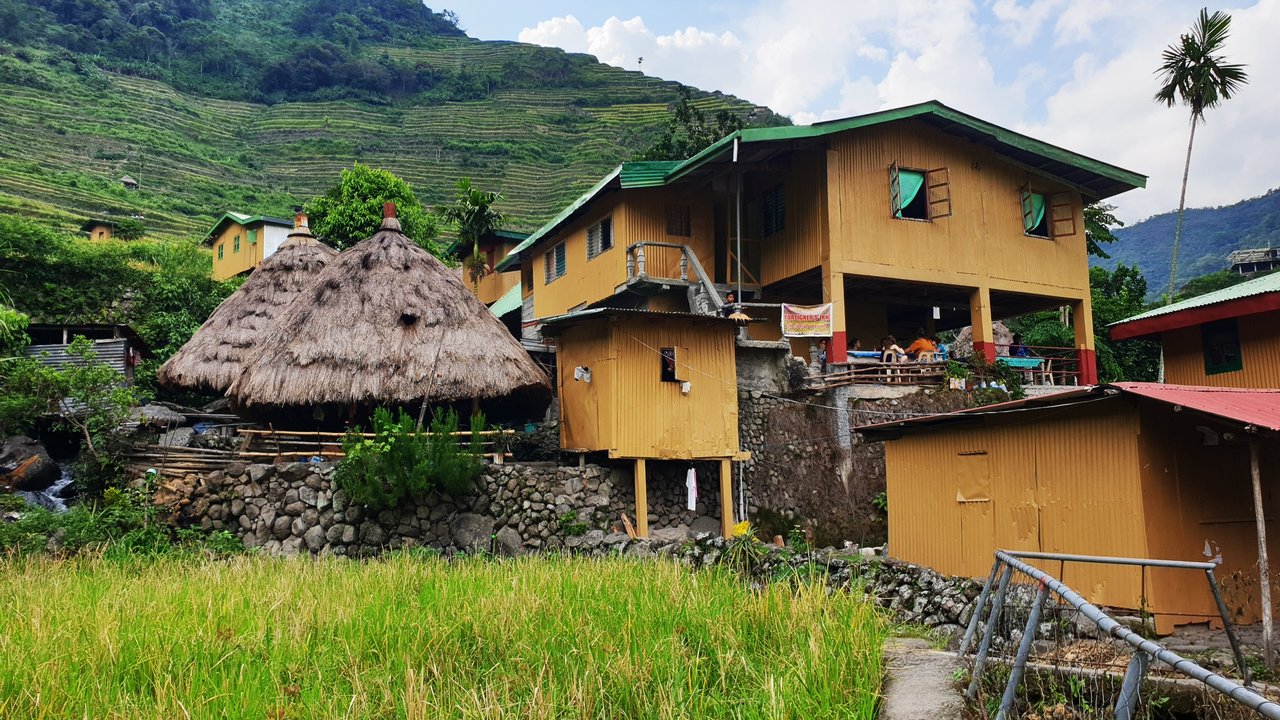
There was a group of foreigners dining in when we arrived. We occupied the vacant table next to theirs and watch back to our fellow volunteers who are still on their way to our inn.
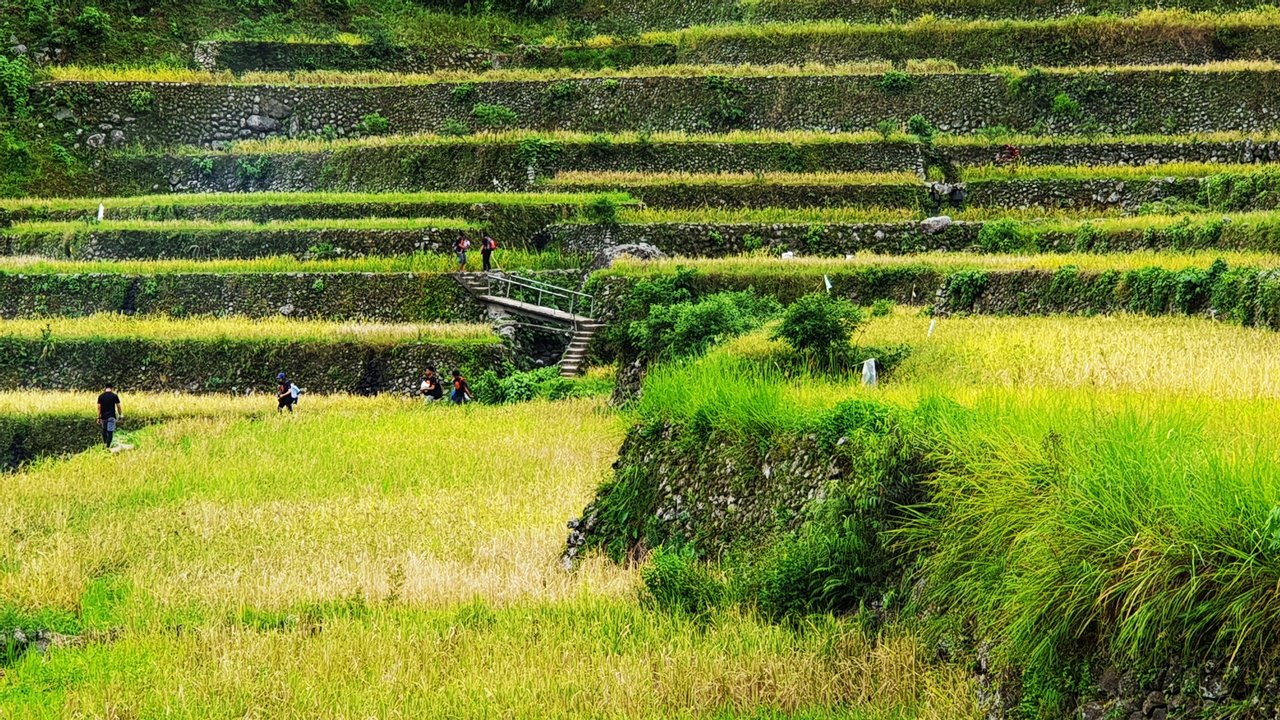
Some of them obviously have difficulties keeping steady along a narrow dike. If you are a city kid who never lived in a place like this then yes, you will certainly experience the challenges even for just walking along a leveled rice field dike. So far, none of them fell off. Everyone reached the inn safely.
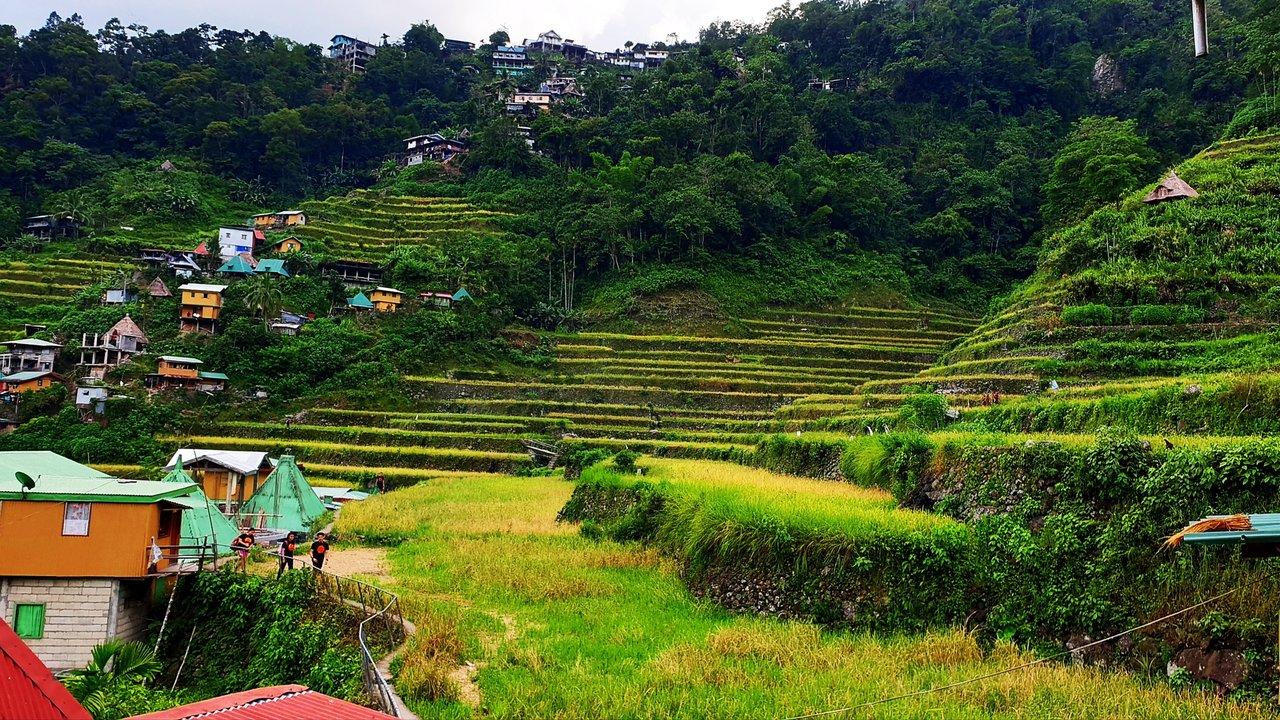
We settled our stuff in our different rooms. I shared a room with Justine, Anne and Jen. In the evening, we all had our dinner together. After that, we had our socializing. Each of us introduced ourselves with more details than just saying our names when we met at the departure area last night. What was really heart-warming to hear from everyone was the purpose that brought us all there. Everyone has their reason of joining but in summary, our goal was to help. And that is what matters.
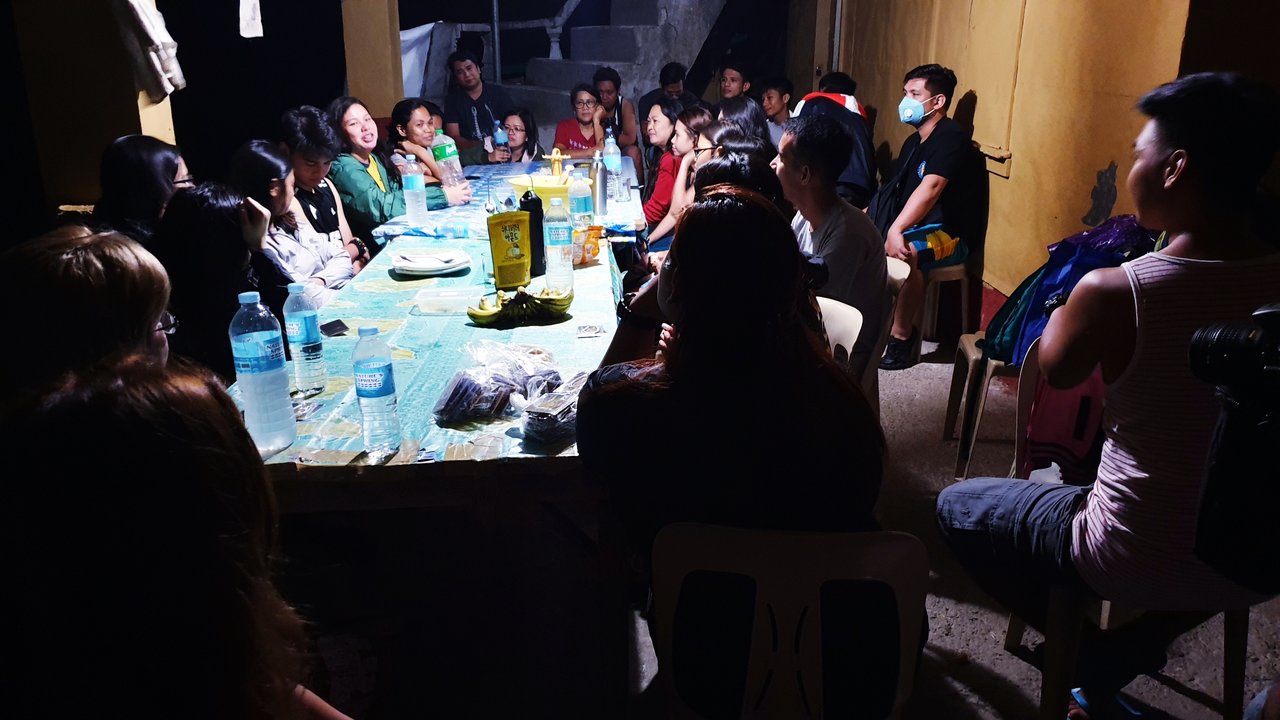
I felt the rice terraces under my feet. I smelled them right under my nose. I can not find the right words to describe my feelings but I just loved it!
That was one great day of reaching out and hiking. Tomorrow is another day for the hike to Tappiya Falls. Lights off for now.

Join #ccc for Guaranteed 👍 Daily Income 💵 and Payout 💸 for Newbies \(2.0\) 🐟 🐜 🐛 in #ccc 👣 and Follow 👣 the Honor Code 🏅 \- the Creed \(Conditions and Limits Inside\) AND the latest update <<< please click to read.



View this post on TravelFeed for the best experience.
